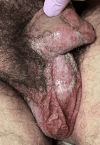Survival Following Steroid-Based Therapy in a Case of Penicillin-Induced Stevens-Johnson Syndrome and Toxic Epidermal Necrolysis Overlap
- PMID: 40621364
- PMCID: PMC12229234
- DOI: 10.7759/cureus.85396
Survival Following Steroid-Based Therapy in a Case of Penicillin-Induced Stevens-Johnson Syndrome and Toxic Epidermal Necrolysis Overlap
Abstract
Stevens-Johnson syndrome (SJS) and toxic epidermal necrolysis (TEN) are life-threatening mucocutaneous reactions with mortality rates strongly correlated with disease severity. We report the case of a 47-year-old Mestizo man in Nicaragua with penicillin-induced SJS/TEN overlap syndrome (body surface area involvement: 10%-30%, score of toxic epidermal necrolysis, SCORTEN: 4, and predicted mortality: 58%). The patient developed mucosal erosions, hemorrhagic crusting, and disseminated erythematous plaques following exposure to amoxicillin and dicloxacillin (penicillin-class antibiotics). Initial misdiagnoses delayed care, but hospitalization prompted early intravenous dexamethasone, fluid resuscitation, topical corticosteroids, and immediate discontinuation of the offending agents. Epidermal detachment halted within 72 hours, with complete reepithelialization by day 10. Transient hyperglycemia resolved spontaneously, and the patient survived without infections or sequelae, contrasting with the SCORTEN-predicted mortality. This outcome supports early immunomodulation to mitigate cytokine-driven necroptosis, challenging historical concerns about corticosteroid risks. Limitations include the single-case design, absence of histopathology, and lack of human leukocyte antigen allele screening for pharmacogenomic insights. The case underscores the efficacy of prompt corticosteroids in high-risk SJS/TEN linked to penicillin-class drugs, emphasizing drug-specific vigilance and discontinuation. It highlights the need for population-specific SCORTEN calibration, pharmacogenomic integration, and publication of rare cases to enhance regional epidemiological understanding.
Keywords: dexamethasone; drug eruptions; drug hypersensitivity; glucocorticoids; immunomodulation; penicillin; scorten; stevens-johnson syndrome; stevens-johnson syndrome/toxic epidermal necrolysis overlap; toxic epidermal necrolysis.
Copyright © 2025, Blandon et al.
Conflict of interest statement
Human subjects: Consent for treatment and open access publication was obtained or waived by all participants in this study. Conflicts of interest: In compliance with the ICMJE uniform disclosure form, all authors declare the following: Payment/services info: All authors have declared that no financial support was received from any organization for the submitted work. Financial relationships: All authors have declared that they have no financial relationships at present or within the previous three years with any organizations that might have an interest in the submitted work. Other relationships: All authors have declared that there are no other relationships or activities that could appear to have influenced the submitted work.
Figures








References
-
- Clinical classification of cases of toxic epidermal necrolysis, Stevens-Johnson syndrome, and erythema multiforme. Bastuji-Garin S, Rzany B, Stern RS, Shear NH, Naldi L, Roujeau JC. https://doi.org/10.1001/archderm.1993.01680220104023. Arch Dermatol. 1993;129:92–96. - PubMed
-
- SCORTEN: a severity-of-illness score for toxic epidermal necrolysis. Bastuji-Garin S, Fouchard N, Bertocchi M, Roujeau JC, Revuz J, Wolkenstein P. J Invest Dermatol. 2000;115:149–153. - PubMed
-
- Accuracy of SCORTEN to predict the prognosis of Stevens-Johnson syndrome/toxic epidermal necrolysis: a systematic review and meta-analysis. Torres-Navarro I, Briz-Redón Á, Botella-Estrada R. J Eur Acad Dermatol Venereol. 2020;34:2066–2077. - PubMed
-
- Methylprednisolone pulse therapy for Stevens-Johnson syndrome/toxic epidermal necrolysis: clinical evaluation and analysis of biomarkers. Hirahara K, Kano Y, Sato Y, et al. J Am Acad Dermatol. 2013;69:496–498. - PubMed
Publication types
LinkOut - more resources
Full Text Sources
